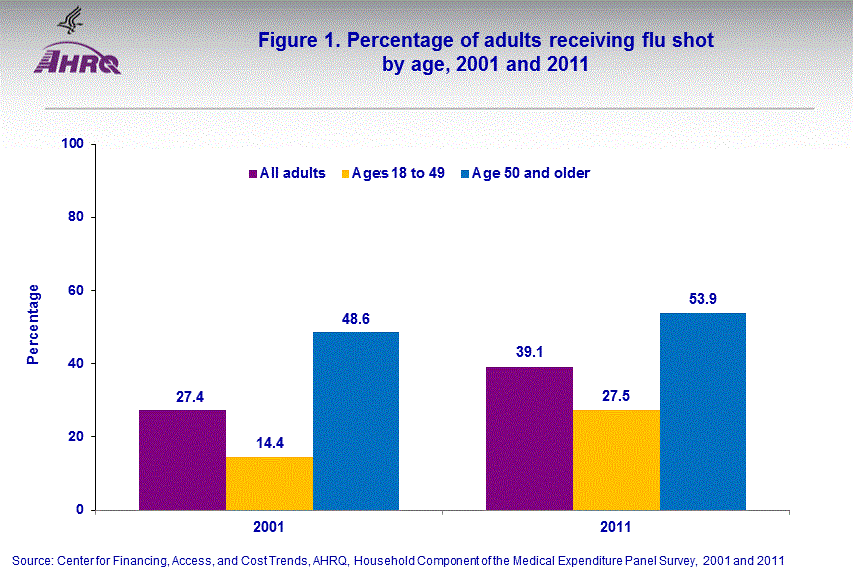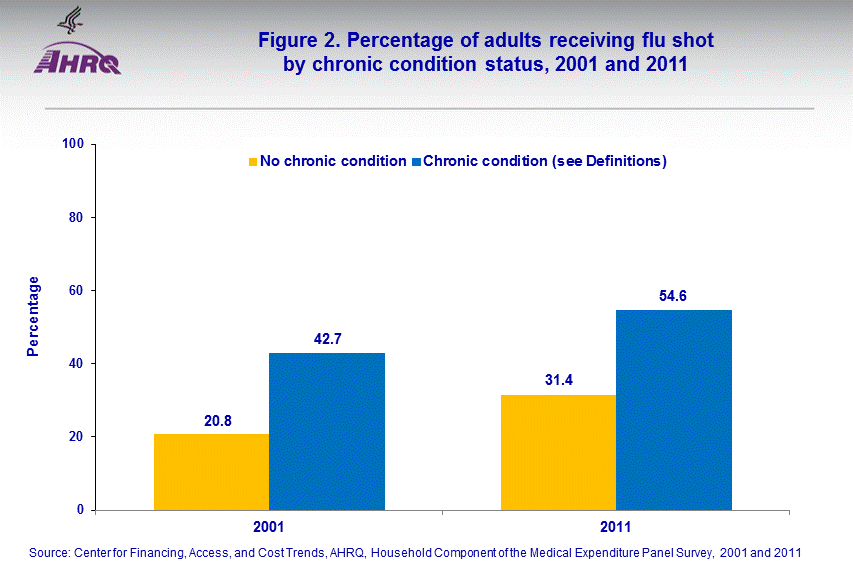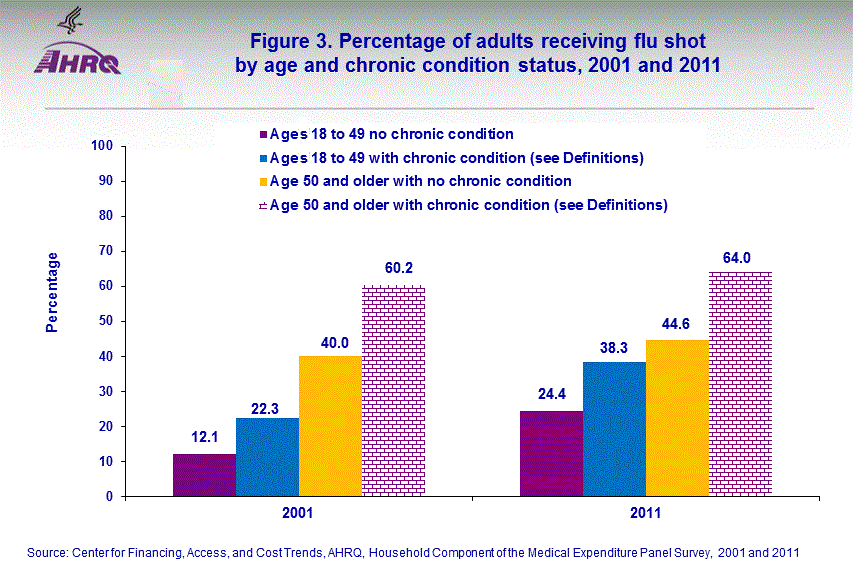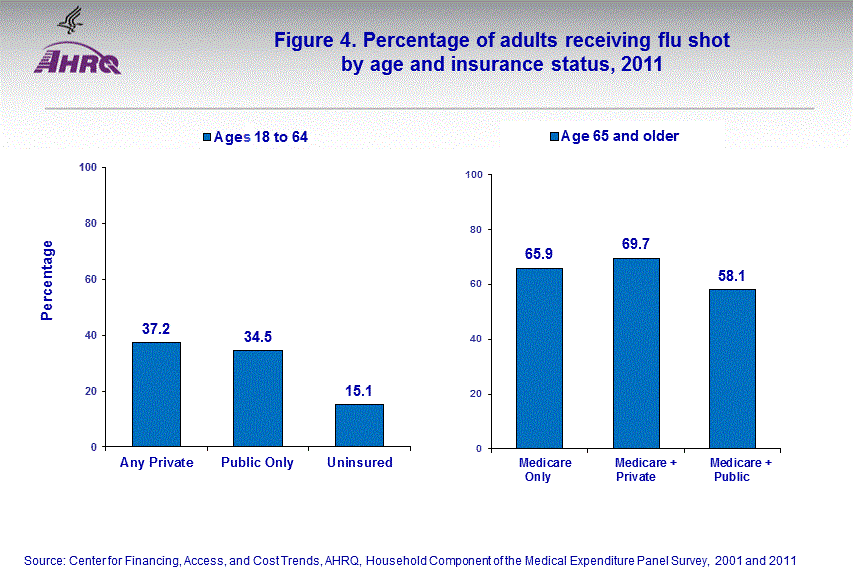
|
|
Font Size:
|
||||
|
|
|
|
||||
STATISTICAL BRIEF #431:
Influenza Immunization Rates for the Adult U.S. Civilian Noninstitutionalized Population, 2001 and 2011
Highlights
- In 2011, about 39.1 percent of adults in the U.S. civilian noninstitutionalized population reported receiving a flu shot in the past year.
- Individuals age 50 and older were about twice as likely to receive a flu shot as younger adults in 2011.
- In 2011, over half of individuals with one or more of selected chronic conditions (see Definitions) received a flu shot compared to about one-third of persons with none of those conditions.
- The proportion with a flu shot was higher in 2011 than 2001 regardless of age or chronic condition status.
- In 2011, adults ages 18-64 without health insurance coverage were much less likely to have received a flu shot than non-elderly adults with private or public insurance coverage.
Introduction
Influenza (the flu) is a contagious respiratory illness caused by influenza viruses that can cause mild to severe illness. Older adults and people with some types of chronic conditions (pulmonary disease, asthma, cardiovascular disease excluding hypertension, renal disease, hepatic disease, degenerative nervous system conditions, hematologic conditions, and metabolic disorders including diabetes) are at increased risk for complications from the flu that may lead to hospitalization or even death. Receiving an influenza immunization may reduce the chance of getting the flu and its complications in most adults.This Statistical Brief presents estimates for 2001 and 2011 from the Household Component of the Medical Panel Expenditure Survey (MEPS-HC) of the percentage of the adult U.S. civilian noninstitutionalized population that reported receiving a flu shot within the past year. Subgroups at increased risk of flu complications are examined including persons age 50 years and older and persons with selected chronic conditions (see definitions section below for chronic conditions included). Variation in the likelihood of receiving a flu shot is also examined by health insurance status. Estimates from the MEPS-HC are based on information provided by survey respondents about themselves and other family members in the household. All comparisons discussed in the text are statistically significant at the .05 level unless otherwise noted.
Findings
In 2011, about 39.1 percent of adults in the U.S. civilian noninstitutionalized population reported receiving a flu shot (figure 1). Individuals age 50 and older were about twice as likely to receive a flu shot as younger adults (53.9 percent versus 27.5 percent for persons ages 18–49). In both age groups, the likelihood of receiving a flu shot increased from 2001 to 2011. The increase for persons age 50 and older was from 48.6 percent to 53.9 percent while for those ages 18–49 it was from 14.4 percent to 27.5 percent.In 2011, over half of individuals with one or more of selected chronic conditions (see Definitions) received a flu shot (54.6 percent) compared to about one-third (31.4 percent) of persons with none of those conditions (figure 2). Both individuals with and without a chronic condition were more likely to receive a flu shot in 2011 than 2001. For individuals with a chronic condition the increase was from 42.7 percent to 54.6 percent while the increase for individuals without a chronic condition was from 20.8 percent to 31.4 percent.
Uninsured individuals ages 18–64 were less likely to have received a flu shot in 2011 (15.1 percent) than individuals in the same age group covered by private or public health insurance (37.2 percent and 34.5 percent, respectively) (figure 4). Individuals age 65 and older covered by Medicare and some other type of public insurance were less likely to have received a flu shot (58.1 percent) than those covered by Medicare and private insurance (69.7 percent).
Data Source
The estimates shown in this Statistical Brief are based on data from MEPS-HC public use files HC-60 and 147 (2001 and 2011 Full Year Consolidated Data Files, respectively).Definitions
Age Defined using the last available age for each sampled person.Chronic conditions The indicator for chronic conditions was drawn from clinical classification codes indicating the presence of the following: chronic pulmonary disease, asthma, cardiovascular disease (except hypertension), renal disease, hepatic disease, degenerative nervous system conditions, hematologic conditions, and metabolic disorders including diabetes. Clinical classification codes were generated via the aggregation of ICD-9-CM condition codes into clinically meaningful categories that group similar conditions using Clinical Classification Software (formerly known as Clinical Classifications for Health Care Policy Research (CCHPR)), which aggregates conditions into mutually exclusive categories, most of which are clinically homogeneous (Elixhauser, et al., 2000).
Health insurance status Individuals ages 18 to 64 were classified in the following three insurance categories, based on household responses to health insurance status questions:
- Any private health insurance: Individuals who, at any time during the year, had insurance that provides coverage for hospital and physician care (other than Medicare, Medicaid/SCHIP, or other public hospital/physician coverage) were classified as having private insurance. Coverage by TRICARE (Armed Forces—related coverage) was also included as private health insurance. Insurance that provides coverage for a single service only, such as dental or vision coverage, was not included.
- Public coverage only: Individuals were considered to have public coverage only if they met both of the following criteria: 1) they were not covered by private insurance at any time during the year, 2) they were covered by any of the following public programs at any point during the year: Medicare, Medicaid/SCHIP, or other public hospital/physician coverage.
- Uninsured: The uninsured were defined as people not covered by private hospital/physician insurance, Medicare, TRICARE, Medicaid/SCHIP, or other public hospital/physician programs at any time during the entire year or period of eligibility for the survey.
- Medicare and private insurance: This category includes persons classified as Medicare beneficiaries and covered by Medicare and a supplementary private policy.
- Medicare and other public insurance: This category includes persons classified as Medicare beneficiaries who met both of the following criteria: 1) They were not covered by private insurance at any point during the year, 2) They were covered by one of the following public programs at any point during the year: Medicaid, other public hospital/physician coverage.
- Medicare only: This category includes persons classified as Medicare beneficiaries but not classified as Medicare and private insurance or as Medicare and other public insurance. This group includes persons who were enrolled in Medicare Advantage (Part C) and persons who had traditional Medicare fee-for-service coverage only.
About MEPS-HC
MEPS-HC is a nationally representative longitudinal survey that collects detailed information on health care utilization and expenditures, health insurance, and health status, as well as a wide variety of social, demographic, and economic characteristics for the U.S. civilian noninstitutionalized population. It is cosponsored by the Agency for Healthcare Research and Quality (AHRQ) and the National Center for Health Statistics.For more information about MEPS, call the MEPS information coordinator at AHRQ (301) 427-1406 or visit the MEPS Web site at http://www.meps.ahrq.gov/.
References
For a detailed description of the MEPS-HC survey design, sample design, and methods used to minimize sources of nonsampling error, see the following publications:Cohen, J. Design and Methods of the Medical Expenditure Panel Survey Household Component. MEPS Methodology Report No. 1. AHCPR Pub. No. 97-0026. Rockville, MD: Agency for Healthcare Policy and Research, 1997. http://meps.ahrq.gov/mepsweb/data_files/publications/mr1/mr1.shtml
Cohen, S. Sample Design of the 1996 Medical Expenditure Panel Survey Household Component. MEPS Methodology Report No. 2. AHCPR Pub. No. 97-0027. Rockville, MD: Agency for Health Care Policy and Research, 1997. http://meps.ahrq.gov/mepsweb/data_files/publications/mr2/mr2.shtml
Cohen, S. Design Strategies and Innovations in the Medical Expenditure Panel Survey. Medical Care, July 2003: 41(7) Supplement: III-5–III-12.
Ezzati-Rice, T.M., Rohde, F., Greenblatt, J. Sample Design of the Medical Expenditure Panel Survey Household Component, 1998–2007. Methodology Report No. 22. March 2008. Agency for Healthcare Research and Quality, Rockville, MD. http://www.meps.ahrq.gov/mepsweb/data_files/publications/mr22/mr22.shtml
Agency for Healthcare Research and Quality. National Healthcare Quality Report, 2012. Rockville, MD. U.S. Department of Health and Human Services. http://www.ahrq.gov/research/findings/nhqrdr/nhqr12/index.html
Centers for Disease Control and Prevention - Influenza Fact Sheet: Key estimates about Influenza and the Influenza Vaccine. Rev ed. Atlanta, GA: U.S. Department of Health and Human Services, Centers for Disease Control and Prevention: http://www.cdc.gov/flu/keyfacts.htm
Centers for Disease Control and Prevention - Who Should Get Vaccinated Against Influenza. Atlanta, GA. U.S. Department of Health and Human Services, Centers for Disease Control and Prevention: http://www.cdc.gov/flu/protect/whoshouldvax.htm
Elixhauser, A., Steiner, C.A., Whittington, C.A., and McCarthy, E. Clinical Classifications for health policy research: Hospital inpatient statistics, 1995. Healthcare Cost and Utilization project, HCUP-3 research Note. Rockville, MD: Agency for Healthcare Research and Quality; 2000. AHCPR Pub. No. 98-0049.
Information about influenza and its prevention: http://www.lung.org/lung-disease/influenza/
2013-14 Recommendations of the Advisory Committee on Immunization Practices (ACIP) http://www.cdc.gov/flu/professionals/vaccination/#2013-14recommendations
Suggested Citation
Rhoades, J.A., and Chu, M.C. Influenza Immunization Rates for the U.S. Civilian Noninstitutionalized Population, 2001 and 2011. Statistical Brief #431. March 2014. Agency for Healthcare Research and Quality, Rockville, MD. http://www.meps.ahrq.gov/mepsweb/data_files/publications/st431/stat431.shtmlAHRQ welcomes questions and comments from readers of this publication who are interested in obtaining more information about access, cost, use, financing, and quality of health care in the United States. We also invite you to tell us how you are using this Statistical Brief and other MEPS data and tools and to share suggestions on how MEPS products might be enhanced to further meet your needs. Please email us at MEPSProjectDirector@ahrq.hhs.gov or send a letter to the address below:
Steven B. Cohen, PhD, Director
Center for Financing, Access, and Cost Trends
Agency for Healthcare Research and Quality
540 Gaither Road
Rockville, MD 20850
 |
||||||||||||||||||||
|
||||||||||||||||||||
|
|
||||||||||||||||||||
 |
||||||||||||||||||||
|
||||||||||||||||||||
|
|
||||||||||||||||||||
 |
||||||||||||||||||||
|
||||||||||||||||||||
|
|
||||||||||||||||||||
 |
||||||||||||||||||||
|
||||||||||||||||||||
|
|
||||||||||||||||||||


